Sweeteners: How They Affect You, Which Ones are Best, and How to Use Them
;
By Natalie, Contributing Writer
Are you working to ditch processed foods and put more real food on the table? This month we’re running a series called Real Food Made Simple: A Beginner’s Guide to Eating Better. Our goal is to answer the questions you might have and make the transition a whole lot easier!
How Sweeteners Affect Your Body
Insulin is the hormone that decides where to store nutrients. It takes glucose, fats, and proteins out of your blood and into your cells so they can be used by your body. When too much insulin is released into your system, it begins to promote the storage of fat. Why?
Insulin’s first priority is to get rid of elevated sugar levels in your blood, so if you are consuming sugars or carbohydrates, that insulin kicks into gear to bring those sugar levels down. First it will transport glucose to the muscle cells, where it can be used up as energy.
But once those muscle cells are saturated, your body has no choice but to haul the excess glucose to the fat cells where it turns into more fat.
Here’s another issue: your body is so efficient, it will clear out all the excess glucose, leaving you with a sugar “low.” This makes you feel tired, cranky, and achy. You begin to crave more carbs (sugars) to counteract that yucko feeling – and a bad cycle begins.
What are Glycemic Indexes (GI)?
Glycemic indexes measure carbs (0-100) from the perspective of their pure sugar/starch content in order to determine how they affect glycemia (blood sugar levels) after meals. (source)
I’m going to put the glycemic index number next to each sweetener, so you can see how each one will affect your body. The higher the GI number is, the higher that item will spike your blood sugar level after you consume it.
Foods with high GIs are suspects in diseases like type 2 diabetes, cancer, and Alzheimer’s.
Sweeteners to Avoid
1. Refined and Semi-Refined Sugars
- White Sugar (GI 80)
- Brown Sugar (GI 80)
- Powdered Sugar (GI 80)
- Corn Syrup (GI 75)
- Turbinado Sugar (GI 65)
- Sucanat (GI 65)
- “Raw” or “Organic” Sugar (GI 65)
These sugars are either refined or semi-refined, are high on the glycemic index spectrum, and will deplete your body of important nutrients, contributing to chronic illnesses such as depression, headaches, heart disease, obesity, diabetes, and cancer.
I’m going to add one more to this list of “no-nos” that might surprise you:
- Agave Nectar (GI 15-30) This sweetener has been very popular in recent years due to its low GI number but is now under attack for the following reasons: It is processed and has no natural nutrient value, it has 16 carbs per tablespoon, and it contains 90% fructose to 10% glucose, which is similar in structure to high fructose corn syrup.
Not good. These unnatural ratios make it difficult for the body to process it, causing 1. triglycerides to rise, 2. improper copper metabolism, which leads to aging skin issues, and 3. a reduction in the sensitivity of insulin receptors, which can contribute to diabetes.
2. Artificial Sweeteners
- Aspartame (NutraSweet, Equal, etc.)
- Saccharine (Sweet’N Low)
- Sucralose (Splenda)
These sweeteners are toxic to your body and have been implicated in neurological and immune disorders.
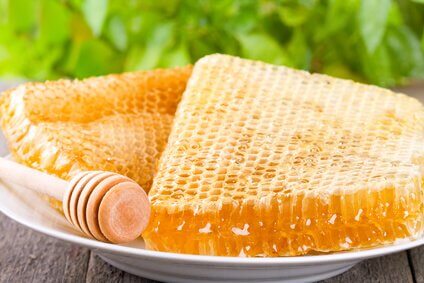
The Natural Sweetener Scoop
There are several natural sweeteners that are packed with trace nutrients that offer some benefit to your body, but this doesn’t mean you should indulge in them regularly. Here’s the rundown on the most common natural sweeteners, their glycemic index numbers, and how to use them.
Date Sugar (GI 70)
Made from dehydrated dates, date sugar is not a good choice for baking because it doesn’t “melt” into the ingredients. It does make a nice, natural topping for oatmeal or cinnamon toast. The GI is really high…so it’s probably a better option for children who don’t need to worry about their waistlines.
Rapadura (GI 55)
Rapadura is unrefined and unbleached dehydrated cane sugar juice and contains potassium, calcium and magnesium. It is a good choice for baking, as it has a similar chemical structure to sugar. You can use it to replace sugar in your recipes in a 1:1 ratio.
Molasses (GI 55)
This is what remains after sugar has been refined. It is full of trace minerals and full of flavor. You wouldn’t want to use it in baking unless you are going for that strong flavor (molasses cookies, for example). I have a to-die-for marinade that features molasses: 1 T. oil, 1 T. molasses, 1 T. Braggs Liquid Aminos, 1 T. minced garlic, and 1 T. lemon juice. Marinade steaks, chicken and chops in this…then grill, serve, and listen to the raves.
Maple Syrup (GI 54)
Maple syrup is a natural source of manganese and zinc as well as other trace nutrients. While maple syrup IS higher on the GI scale, it’s far better for you than Mrs. Butterworth’s fake maple syrup, and it’s delicious, too. This makes it a wiser choice for topping pancakes and french toast.
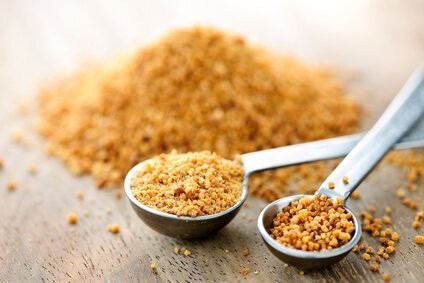
Coconut Sugar (GI 35)
This is the new kid on the block, has a low GI, with sucrose being the main component and fructose and glucose being extremely low. You can bake with this in a 1:1 ratio, but it is slightly less sweet than white sugar.
Raw Honey (GI 30)
Jam packed with trace nutrients, amino acids, antioxidants, and enzymes that digest carbohydrates, raw (unfiltered and unheated) honey is a great choice to drizzle on your morning oatmeal or a thick slice of homemade bread. A little goes a long way, and the enzymes from the honey help your body digest the grains. Raw honey is also anti-bacterial, anti-fungal, and antiseptic.
Raw honey can have a similar effect on your body that white sugar has, so adults wanting to lose weight should use it sparingly, but no need to worry about feeding it to your children, unless they are under one year old. Babies do not have enough stomach acid to destroy the bacteria spores.
I personally choose not to bake with honey because when it is heated, it loses some of its nutrients. It also has a tendency to overpower other flavors, in my opinion. If you do decide to use honey for baking, 1/2-3/4 cup of honey can be substituted for a cup of sugar. You will also want to reduce the liquid in your recipe by 1/8-1/4 cup AND lower your oven temp by 25 degrees.

Stevia Powder (GI 0)
I’m in the midst of exploring this option. I mean, hello. A GI of ZERO?? I tried a brand of Stevia a while back and hated the aftertaste. However, I’ve recently tried a brand that comes highly recommended in Serene Allison and Pearl Barrett’s book, Trim Healthy Mama. It is NuNaturals Pure White Stevia Extract Powder (not NuStevia White Stevia Powder which comes with maltodextrine.)
This product comes in a small, one ounce shaker for about eight bucks. I’ve been using it for a few days now and am pretty impressed. I dash a bit in my morning coffee for perfect sweetness. It does a bang-up job in smoothies. Just a few dashes in my Vitamix (I make smoothies for 8), and we’re good to go.
Stevia helps stabilize blood sugar, makes a great digestive aid, inhibits bacterial growth in your mouth, lowers hypertension, heals skin problems, and is economical. Did we die and go to heaven?
I havn’t tried this yet for baking (a future post in the works here?), but because it is heat stable, the authors use it exclusively. The amounts used are minute. For example, in one of their cake recipes they use 1/8-1/4 teaspoon of the stuff to sweeten the whole thing.
Erythritol (GI 0) and Xylitol (GI 7)
These are both sugar alcohols (note those GI numbers). While not so sweet on their own, they are perfect when mixed with stevia. There is a brand you can get at the grocery store, Truvia, that mixes erythritol with stevia in proportions that taste great. It is more expensive than just using stevia because you need to use more to get the same results.
Other posts in the series:
Real Food Made Simple: A Beginner’s Guide to Eating Better
Cutting Your Kitchen Prep Time in Half — Or More!
Confessions of a Formerly Picky Eater
The Grain Controversy: Should We Eat Them or Not?
Second Steps Towards Eating Real Foods: Switching Your Food Sources
Simple Steps to Begin Cooking Homemade: Pantry Staples
5 Strategies to Help Your Husband and Kids Transition to Real Food
Finding Real Food in the Grocery Store
20 Easy Real Food Switches and Substitutions {with Free Printable Chart}
First Steps to Eating for Fertility
Keeping Costs Down in a Real Food Kitchen
5 Ways to Get More Fruits & Veggies into your Diet
Food Is Not Cheap: 4 Steps to Budgeting in Real Food
Simple Steps to Begin Cooking Homemade: Baked Goods
Simple Roast Chicken (And Fabulous Side Dish Recipes!)
17 Homemade Spice Mixes {with Recipes & Why You Should Use Them!}
5 Ways Green Living and Real Food are Connected
Simple Steps to Begin Cooking Homemade: Soups, Sauces, and Simple Dinners
Now it’s your turn:
What are your favorite natural sweeteners, and how do you enjoy using them in your food preparation?
*Disclosure: This post contains an affiliate link.
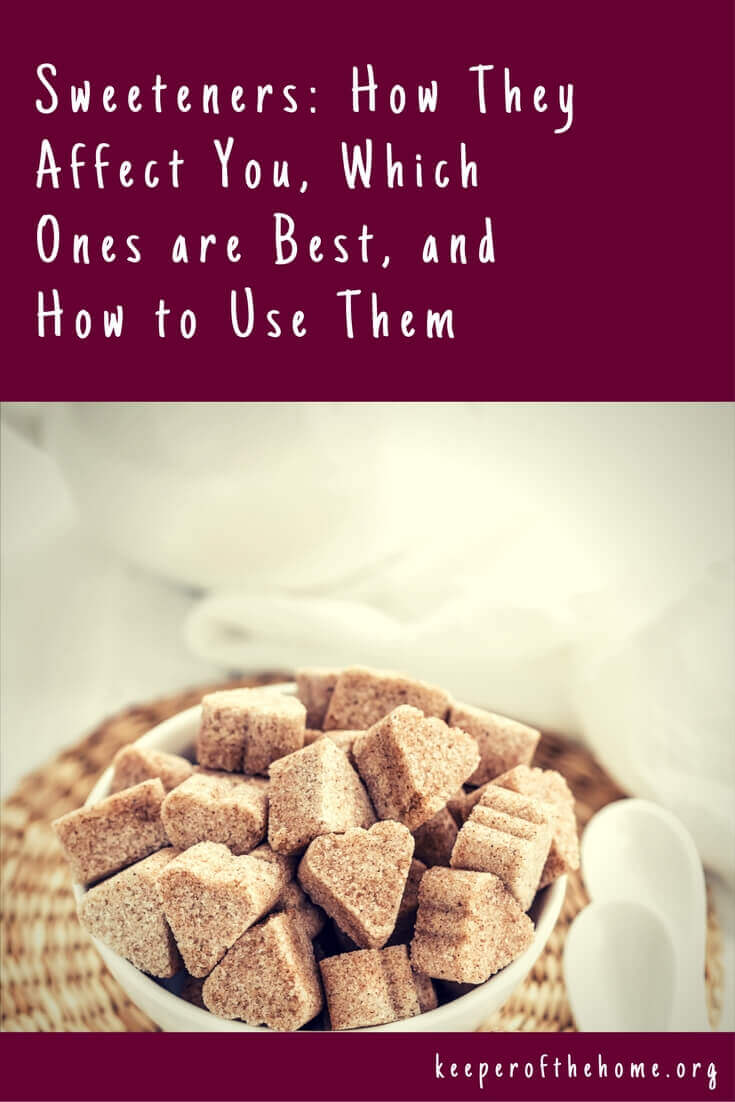
;

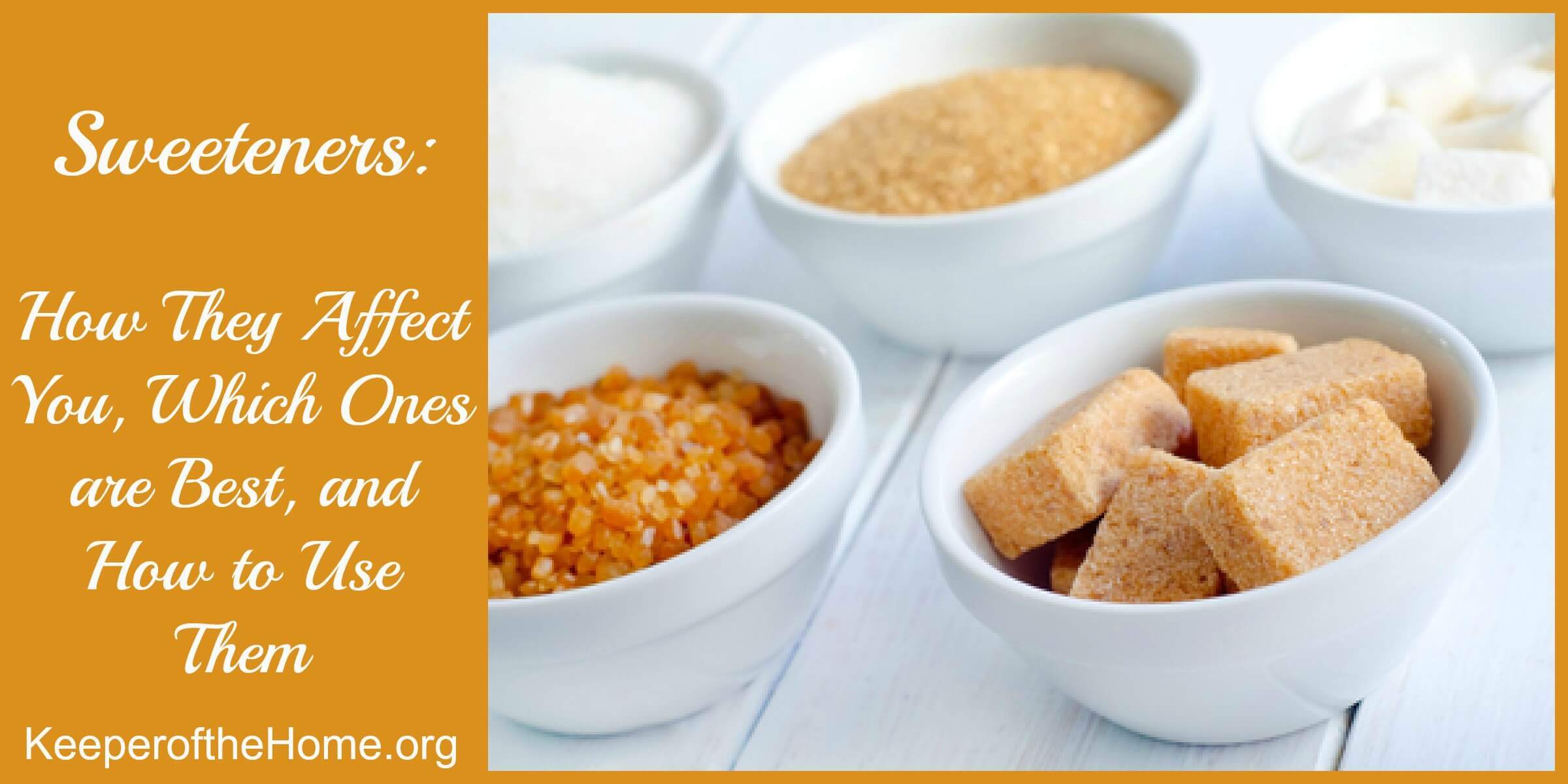
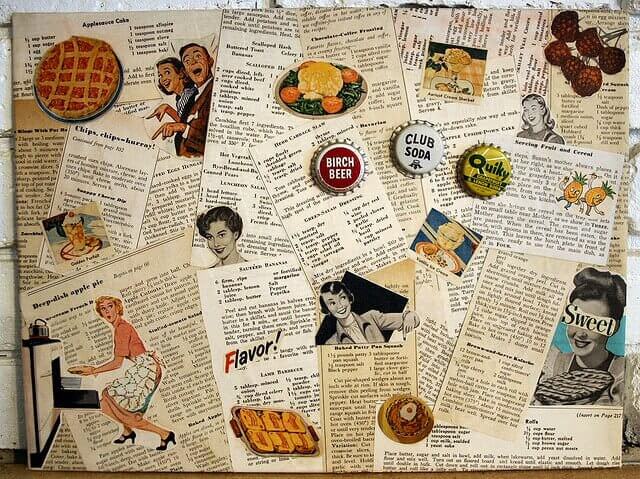

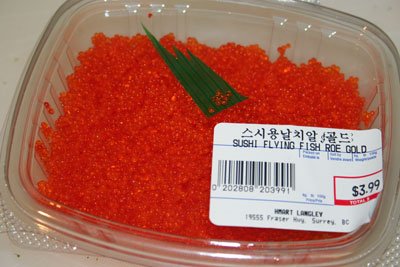


so I guess as I sit here sipping my dunkin’ donuts coffee with hazelnut coffee mate, it means i’m not being a good girl… 😉 Wonderful news to here, great to see the options. Hard to change your habits! Thanks for this post as I can keep referring to it in my challenge to eat properly. Why must sugar be so good?!
Haha, I love your honesty 🙂 It *is* hard!
Sugar is so good because its an addictive substance: http://www.naturalnews.com/034478_junk_foods_addictive_brain_chemistry.html
i completely understand & empathize w/ u, kallie! i was a complete sugar addict until i met my husband. he slowly started to wean me off of it, but the true change came when we started back in july ’12 to be seen by a dr. that subscribes to eating patterns the same as the weston a. price foundation & sally fallon. i’d encourage you to GRADUALLY cut back on sugar, try using some of these natural sugars, & i think that you’ll agree w/ me that they can be quite satisfying to a sweet tooth! =) happy learning & experimenting!
This is a great article; just one point to make: it is my understanding that both TruVia and PurVia are processed with ethanol, and, therefore, should be avoided.
Yes, they are chemically processed. It is the only way they could get a patent on their “brand” — since Stevia is a natural plant. Easy to grow in a pot, but thrives in warmer climates in the soil. 🙂
I probably should have added in original comment (still getting the first cup of cafe au lait down!) that it is very easy to grow your own stevia, and it makes a lovely houseplant or greenhouse addition; it’s a plant; just pick the leaves, dry, process into powder using your blender, if that’s the form you want – or, just use the leaves and remove them, or, not (after drying them). You can buy seeds from most organic seed producers, but you can often find the plant these days in nurseries – spring is just around the corner, you know!
I find it very interesting that Agave should be on your list of no-no’s. I’m not sure that I agree with your arguments against it at this point, but I do intend to do further research. What sugar is not “processed” in some way, shape or form? And it’s plant-based, so why would it be a surprise that it’s mostly fructose? Do you have any links on the reduction of sensitivity of insulin receptors and accelerated aging of the skin?
This is seriously one of the best articles on sweeteners I’ve ever read! A perfect mix of the science-y explanation with the relevant other stuff. Loved it. I was surprised to see sucanat on the NO list, as so many real-foodies use it! Also, I could have sworn that coconut palm sugar has a lower glycemic index than honey (I thought I’d read that somewhere, but I could definitely be wrong). I love using it as a sub for white sugar because it’s the same texture (granulated). Off to share this with my followers (and my family members who are on the SAD!).
I have read in a number of places that sucanant and rapadura are the same product, just that one is a brand name. I’m sad to see that they’re not. I use sucanat (sparingly) when I don’t use honey, maple syrup, or molasses. I also ordered the stevia herb that is just cut and dried (still green) and put a pinch of that in our smoothies. We love it! I am looking forward to reading Trim Healthy Mama; I saw it a while back but haven’t gotten it yet. With baby #6 due in 4 weeks, I’m sure I’d find helpful information in it!
Hi Micah! See my comment above. Also, I’m going to be doing a review on KOTH of Trim Healthy Mama in February. Congratulations on your upcoming birth! Those last few weeks of anticipation are magical, aren’t they? (Hard too…!)
I’m with Micah on this– thought that Sucanat was a brand name for rapadura sugar. Looking at the two, I can’t tell them apart. But you’ve got one on the no list and one on the yes list, so there must be a difference! Can you explain for those of still using sucanat? Thanks 🙂
I’ve also always believed this to be true of sucanat. I’ve read it from many, many sources. If they are not the same, it would be good to have a breakdown of the differences.
Rapadura is a raw, dehydrated cane sugar rich in minerals, but can affect the body chemistry the way sugar does. Sucanat, “Florida Crystals”, turbinado, raw, and “natural” sugars are all refined. The nutrients have been removed, so you may as well use regular sugar and save yourself some money. 😉 See Nourishing Traditions by Sally Fallon for more information.
Here is a response about Sucanat vs. Rapadura from the Weston A. Price website FAQ section:
Q. I’m confused as to which type of sugar is better, Sucanat or Rapadura?
A. Both are fine; both are made by dehydrating cane sugar juice. For a while Sucanat changed the way they made it and were using white sugar, so we stopped recommending the product. But they are now making Sucanat the old fashioned way, so we can recommend it again.
The Sucanat I have is made by Wholesome Sweeteners and says “dehydrated cane juice.” Organic & Fair Trade Certified. The sugar is not refined (aka it is not a little “square shape.” They are circular, different shaped particles of all different sizes). I agree with the turbinado and Florida Crystals, those are absolutely refined and are avoided. I remember looking into this once before I was getting into Traditional Foods, and they really are the same thing. I’m not about to throw out all the sucanat I have (and have had for a while) and realize that even natural sugars should be used in small amounts.
Yes – this is the brand of sucanat I get and mine is not refined at all.
Yes, the processing of sucanat has changed over the last few years and is now basically equivalent to rapadura, which is a brand name. I’ve had Florida Crystals (using for a sugar scrub) and they aren’t anything like sucanat is currently.
Sucanat is the ‘brand name’ for rapadura.
We love rapadura. My husband is from Brazil so it is something we are very accustomed to!
Where would I find the Rapadura?
You could get it at your local health food store. Google it to find online options.
Loved this simply explanation. No metion of “regular” table top honey. I know that it was not as great as raw honey, but I thought that it was ok for baking since the heat would break down the raw honey. Thoughts?
I’d stay away from it. The nutritional value has been removed and there are better alternatives. 🙂
Also, often honey in the stores is actually honey flavored “high fructose corn syrup”.
I have decided that only organic honey is safe. Costco, for example, said that their honey is pure American honey, not cut with corn syrup. But then they said the hives were placed in corn fields out west. Since 90% of American corn is GMO, what is the chance that there is no GMO material in the honey? Similarly, non-organic honey has traces of the pesticides/herbicides that were used on the crops that the bees are getting their nectar from, and the pesticides/herbicides are more toxic than ever before. Would you like a little Roundup or Agent Orange in your honey?
I have heard heaps of bad things about Xylitol. I don’t understand them all, but it warrants more looking into. Otherwise a great article! I had been under the impression that sucanat was interchangeable with Rapadura when I heard so many natural food bloggers using it. But it does look way different and NT says sucanat is not good. I have yet to understand the difference in processing, though.
Just a warning to some of your readers….you can be allergic to alcohol based sugars. I found out when gums started using sorbitol and xylitol when I kept getting stomach cramps after chewing gum. Xylitol is now in just about everything dental related and sorbitol is in a host of medicines like airbourne. If you find you don’t feel well after chewing gum or eating a candy or taking a medicine with flavor added check and see if it has one of these ingredients.
Love this article. I use Stevia for so many things. Truvia, while better than Splenda or aspartame, is still adulterated and not what I would call “healthy”.
I make my own liquid vanilla stevia extract, as well, from the concentrated powder version. We use this for sweetening my kefir, and my husband uses it for coffee.
I make an AWESOME chocolate bar — with unsweetened baking cocoa, vanilla, coconut oil, pure stevia, and raw honey. SO good, you can put a dash of cayenne pepper in, a dash of cinnamon, etc.
I have been without sugar now for 4 months and my life has changed. I still will eat raw honey, molasses, pure maple syrup, Stevia, and an occasional organic cereal with pure sugar cane in it, but no processed sweets AT ALL. I avoid agave nectar like the plague!!
I mostly use honey and maple syrup because they are local sweeteners for our area. I love being able to stop at my neighbors to pick it up! My understanding of Xylitol (and erythritol) is that it mostly is produced from corn (GMO) in North America and has a highly refined extraction process, am I incorrect? I was considering using it in my eggshell toothpaste that I make but decided to leave it out because of that, but it would definitely add a better flavor.
Xylitol is not safe, and is especially deadly to pets, even in very small doses.
In addition, after learning that Stevia can be an abortifacient, I’m wary of its use.
What about Palm Sugar? I saw someone say they use “coconut palm”. Are palm sugar & coconut sugar the same? I didn’t think so. Also, does coconut sugar have a coconut flavor? I’ve been trying to do better on the sweeteners by going with raw sugar (as well as more maple syrup and honey), but it appears that the raw is not quite good enough.
Thanks for this great article. I’ve really been wondering more about the sweeteners lately. I’ve stayed away from the fake sweeteners for years, but I’m glad to see where I’m still falling short.
They are different. Wikipedia: Palm sugar was originally made from the sap of the Palmyra palm, the date palm or the sugar date palm. Now it is also made from the sap of the Arenga pinnata (sugar palm) and the nipa palm, and may therefore also be sold as “arenga sugar”. Palm sugar is made by making several slits into the stem of a palm tree and collecting the sap. The sap is then boiled until it thickens.
Palm sugar should not be confused with coconut sugar, which is made from the sap of cut flower buds of the coconut palm, instead of from the sap of the tree itself.[1]
Thanks for that explanation! So, does that mean that palm sugar is a safe sweetener or not? I noticed the boiling process as part of it.
Here is a link from Sally Fallon stating that Sucanat and Rapadura are the same.
http://www.westonaprice.org/faq/faq-miscellaneous-food-questions
This is an interesting article. I have yet to find a stevia product that I can stand to use. I have a highly developed “bitter” taste, and all stevia, even in minute amounts, tastes unbelievably bitter. People are always saying, “try this brand”, or “that brand, it’s great and not bitter”. Well, to me they all are.
I have a friend who has tried MANY different Stevia products with the same complaint. The one she LOVES (and I do too) is the one mentioned above: NuNaturals Pure White Stevia Extract Powder. I think you will be pleasantly surprised. I refuse to eat anything I don’t LOVE. I am so excited about this stevia brand. 🙂
Interesting and informative to see an overview of the different choices and comparisons at a glance. I use honey in most of my baking (bread, muffins, etc), except for the recipes that need to be crunchy, not cakey in texture. For those I have been using scant Sucanat, as I was with the understanding, as many here, that it was a whole/unrefined evaporated sugar like Rapadura. It was also enlightening to read that honey has one of the lowest GIs of the natural sugars–I have heard that even though it is an unrefined product, that it still can be just as to be avoided for someone with diabetic tendencies, etc.
I enjoy using glycerin Stevia extract in a tea concentrate for my parents, and sometimes have steeped the herb itself. Otherwise, I prefer teas/coffees unsweetened anyways. Have not yet tried dried stevia powders for baking…to me it sees the resulting goodies would have a strong herby taste.
We’re just finishing up our first week on using the Trim Healthy Mama book, and I have to say that it’s the first “diet” or lifestyle eating book that has ever made enough sense to me to want to use it! We’re very satisfied with the recipes. Several of us lost 3-4 pounds this week without even trying to be good – just by using their recipes.
The only thing that we’ve really not liked is their chocolate desserts made with stevia. Chocolate is a difficult flavor to master and sweeten with any artificial or different type of sweetener other than honey, sugar, agave, etc. What we have figured out so far is that even though I have the 1 oz. container of the NuNaturals Pure White Stevia Extract Powder like Trim Healthy Mama suggests, it is still bitter. All four of us couldn’t stand anything we made using it: Skinny Chocolate, Chocolate Mini-Cakes, etc. So what we’re using now are NuNaturals liquid stevia drops! They taste so much better than the powder form!
I was very blessed to win $89 worth of NuNaturals stevia products on someone’s blog about a month ago – perfect timing to now using the Trim Healthy Mama book and recipes. NuNaturals sent me liquid stevia drops in flavors of lemon, orange, vanilla, mint, chocolate, and a couple of others (I don’t remember). They definitely taste a lot better than the powder – 100% better than the powder, in our family’s opinion.
I made the Tummy Tucking ice cream cubes and put them in the freezer a couple of nights ago; whipped up the ice cream last night, and it was quite good! Not exactly the same as regular soft-serve ice cream, but pretty great as a substitution! We are loving that book!
Thank you for sharing about the different sugars and sugar options. I think it’s fascinating for people to learn that even their healthy sweeteners are not good at all for people who are needing to lose weight or for those who are pre-diabetic or diabetic.
Thanks so much for this valuable research and information. With obesity every where even in children managing sugar intake seems more attainable and easy to start pursuing with this breakdown. Thanks again…Sue
Put a tiny pinch of dried stevia leaves ( I buy it at my local herb shop) in your loose tea or with your coffee grounds before you brew. The dried leaves are surprisingly sweet, I tossed several pots of tea before I got it right.
Great Post! Thanks for all this info. I was using agave nectar in my coffee but switched to honey. I returned three bottles of agave nectar to the store the other day. I was deceived that it was a healthy alternative. I am cutting back on my sugar intake but I do enjoy a treat every day 🙂 Usually it is a dark chocolate or milk chocolate piece of candy. I buy the individual pieces as one is enough but if you open a whole bar how can you stop?!
Have a beautiful day!
You wrote: “I buy the individual pieces as one is enough but if you open a whole bar how can you stop?!”
I say, “Amen, sister.”
This is such a great post, and I was SO happy to see it today! I’m trying to eat a more wholesome diet, and make healthier choices. One of which was ditching soda and drinking sweet tea (in moderation!). I have been very unhappy using white sugar, and just learned of the Stevia drops and powder in the last week. I’ve been doing some price checking but I wasn’t sure if it was a good option or not. This has given me the last push I need to go ahead and give it a try! Thanks for sharing!
Thank you, a great post, good to know, it goes on my Pinterest!
Sometimes a sweet drink is just so good :). Water Kefir is a healthy SWEET drink that we enjoy!
I’ve always been a little concerned with using Stevia, because I’ve read a number of articles about the use of Stevia being related to fertility problems. Does anyone know anything about this?
This is addressed in Trim Healthy Mama. It’s basically an urban legend. No scientific studies have confirmed that rumor, yet it continues to circulate. Here’s what they also say, “Serene has become pregnant three times while enjoying liberal amounts of stevia in her diet. We personally know many other women who use stevia and have had no trouble getting pregnant. Infertility can be caused by so many things, but we have yet to see any credible evidence that stevia should wear the blame. It has been used for thousands of years by women of childbearing age, and it was never used in history as a means for birth control, or to lessen fertility.”
There is a tiny bit of evidence for this, although it has never been studied in humans, and this study also doesn’t address females: http://www.ncbi.nlm.nih.gov/pubmed/10619379
Thanks for the information. Can you explain the difference between Grade A and Grade B maple syrup? I always have a hard time knowing/deciding which one to buy.
See Wikipedia article here: http://en.wikipedia.org/wiki/Maple_syrup
I thought Sucanat and Rapadura were the same exact thing, just a different brand? Could you please explain how they differ? I have always used Sucanat because it is a bit more affordable and available.
See my answer in the comments section below! 🙂
I have used sorghum in place of molasses in recipes. My impression is that sorghum has more nutrients and isn’t as processed as molasses. Anybody have thoughts on this? Also I ran across Organic traditional barley malt syrup that was right next to the sorghum. The only ingredients are organic sprouted barley and water. I’ve never heard of this. Any ideas on the nutritional value of this?
I have also used sorghum in place of molasses, and from my understanding, it’s fine. I’m not sure on the barely malt, mostly because I’ve never really looked into it. Perhaps another reader has an idea? Or Natalie? 🙂
Hmmmm… I know a lot about chocolate malts and how much I like them. Barley malt? Not so much.
I know that I can’t give anything with barley malt to my kids (allergic to wheat) or to any one with celiac.
What is the difference between sucanat and rapadura? I was told they were the same thing, but rapadura tends to look more like “sugar in the raw” where sucanat looks less refined (when I have bought it at least), so I have used that as my main sugar for the last few years.
My sucanat definitely looks the most unprocessed! It is rough and crumbly….no crystals anywhere. 🙂
I was under the impression that they ARE the same thing – Sucanat was simply a brand name for rapadura. My sucanat simply says ‘evaporated cane cane juice. It’s very rough and crumbly and brownish.
Thank you for this information! I am definitely going to look into Stevia.
Great post!!! 🙂 Around here we use: honey, maple syrup, sucanat, stevia, and coconut sugar…but we’ve cut back on all of them except stevia in order to see if we can shed a little weight. 🙂
Stacy, that makes sense…(heh heh)
Ha, Ha. I never heard THAT ONE before. 😉
Xylitol and erythritol are pretty controversial among real foodies. There is some evidence of benefit, and some evidence they maybe aren’t so good for us. Also, Truvia is a processed extract of stevia, not pure stevia. Stevia is best used unrefined (as with almost anything). I also found several studies showing that the GI index may not be the best indicator of how healthy something is or not.
Best to stick to the unrefined sweeteners — honey, maple syrup, sucanat (which is processed basically like rapadura now) and use in extreme moderation.
I know, and I agree with you. I’m not entirely on board myself with those two sweeteners (though we do use Stevia in our home). It’s interesting, though, the book that Natalie got some of her info from (Trim, Healthy Mama) is co-written and one of the authors is a total real food purist, and she still recommends them and says that she’s happy with the research that she’s done into them. I respect her opinion and I would really like to try to talk to her and see what makes her ok with the use of those sweeteners.
I just have to add that, while I don’t want to bad-mouth them, and have appreciated meeting them in person and learning from Serene….I can’t help but take everything they say with a big grain of salt. I have mixed feelings about their latest book; reconciling it with the real-food knowledge I have. I don’t feel like it meshes with some of the common-sense approaches we take, and while I’m not opposed to learning (I know I can do better!) and I also know that weight loss isn’t super important to me (at 22 and blessed with breastfeeding doing a good job of shedding pregnancy pounds….I know I’ll have to eventually; just give me a few years! ;-))….I’m not gonna jump on their bandwagon just because they say too. Serene, after all, destroyed her own health, and that of the babies she conceived while on her raw-food-only rampage for several years. It took her a long time to restore her health from all the damage. Her babies teeth are permanently damaged. So anyway- while they do put in research, and I certainly respect that, make sure to put in some of your own, too! 🙂
I admire that Serene honestly tells her story in the book. Rather than covering up the truth, she puts herself in a position to be criticized in hopes that others will avoid the same mistakes she made. A bit of advice I heard from an older woman many years ago when I was young: “When reading a book, chew the meat…and spit out the bones.” While there are bones in this book…as in all books…there is some good meat there too for those who are not as informed on nutrition and healthy eating. And yes…for those who are just learning…reading widely on this topic would be better than just reading one book.
I love stevia, but it can cause polyhydramnios (too much amniotic fluid) during pregnancy. I ended up with polyhydramnios and was thinking that my smoothies containing stevia sweetened protein powder wre partially to blame? We’ll never know.
I received the “Trim, Healthy Mama” book for Christmas and I have to say I was very surprised by some of the recommendations, especially knowing that one of the authors is a food purist. I was also surprised that even though they highly recommend coconut oil, coconut flour is never mentioned. I’m looking forward to your review of this book. I’ve implemented a couple of things, because they make sense, but still unsure of products like the Jay Robb protein powder, which contains lecithin, the heavy stevia reliance, etc. Thanks for such a clear, concise post on sugars!
One of the things to keep in mind about this book is that the authors are focusing on helping women stay TRIM. Their recommendations are based on that focus. If a woman is already thin, eating healthy, getting exercise, etc. then she doesn’t need to apply some of the more stringent or “over-the-top” recommendations given. For example, they recommend staying away from starchy fruits/vegies like white potatoes and bananas. If you had a weight problem, then those might be good recommendations to follow for a while. If not…then you don’t need to worry about it so much, recognizing that they do cause sugar spikes. That’s how I read it, anyway. 🙂 They also recommended some crazy “no-nos” about eating out. Like, no tortilla chips at a Mexican restaurant. Huh? I’m sorry, but when I get the rare privilege of eating out…I’m eating EXACTLY what my heart desires. For me, that’s the point of splurging and eating out – the enjoyment of eating delicious things I don’t get to eat at home. Don’t most folks like to kick up their heels and celebrate life with feasting once in a while? Of course they do! 🙂
OH, yeah! No sugar at home, but when I eat out I go all out! I have cake and ice cream!! Ha 🙂
Agreed! 🙂
I use stevia all the time you can get 3.5 oz pure stevia by “kal” through Vitacost.com for around $20.00, an amazing deal!
Thank you for this article. I am diabetic and have had a time with the sweetener issue. I thought I was doing better for myself and now realize I was not. I have had questions about stevia as to how it would affect my condition. Now I realize it would have no affect. No wonder the businesses have not been pushing us to use Stevia it would put all of the no calorie sweeteners out of business in the diabetic community. Thanks again for a very informative article.
What about Oligo? My naturopath told me that I could try it since I’m allergic to honey.
i grow my own stevia. =]
I have been using a combination of stevia (liquid drops) and Xylotol for a few years. I like xylitol for what it does. It makes a really good sugary mouth feel that stevia alone just can not deliver. It is also well behaved in baking uses. It contributes to the structure of a cake. Everyone raves about my fresh lemonade. No one can tell it is sugar free. Xylitol is supposed to be alklinize the body. My dentist is happy that we use it. I’m always trying to go with less sweets, so these “less sweet” things are getting me closer.
Thank you for this article it was really informative. I am new to cooking whole foods and I have been using Sucanat for baking and cooking but it has a distinct flavor that we can always taste. Is their another sugar that dosen’t taste so strong? Thanks
This comes at a perfect time, as I am trying to hard to reduce my sugar intake this year. I have a real bad sweet tooth. Though my kids don’t each much in terms of refined sugar, I just can’t seem to get enough – not the greatest when you are breastfeeding a 10 mth old. One of my goals is to slowly get rid of some of these refined sugars and so far it has been working well. Though admittedly I use maple syrup much more than I would like, which I notice is quite high. But it adds such a wonderful flavour, especially to plain yogurt!
The website Netrition.com carries the Now brand of both Erythritol and Xylitol. Now has an excellent reputation for being very pure and less processed. You can make your own
“Truvia” that’s not near as expensive. I buy the NOW brand of HIGHLY concentrated stevia powder from my local health food store. 1 tsp. is the same as a cup of sugar. Just a dash in your muffin or granola recipe, your spaghetti sauce or homemade soups or chili where you want just a bit of sweetness. I wouldn’t put the super high concentrated stuff in my coffee however!
I’ve been reading Trim Healthy Mama too! I have a love/hate relationship with Stevia…. ONE DROP in my coffee is great, two drops is way oversweet with a horrible aftertaste. It’s weird. And I’ve been eyeing coconut sugar in the HFS and wondering about that, so thanks for the info!
Very useful information – thank you!
I have used Stevia before but like you didn’t like the after taste. I am not conviced about the sugar alcohols. I like to stay away from anything too processed. In Brazil, we had an abundance of rapadura, but here in the US it’s expensive. So I just stay away from sugar.
What I have been doing lately is going without any sweetener at all!! In my latest recipe (check out my blog link) all I use is mashed bananas as a sweetener. In my smoothies, I use coconut or almond milk (which are naturally sweet) or just fruit like bananas or blueberries.
When I drink coffee I go without any sugar now, just a splash of REAL cream. And it is fantastically sweet!
My kids and husband like their maple syrup on pancakes. I buy raw honey now and again for the kids to drizzle on their fruit salads or homemade cereals. Trying to go as natural as nature intended!! hahaha 🙂
Does anyone know anything about Monk Fruit Extract as a sweetener? I inadvertently bought some today (thought I was buying liquid Stevia…shopping in a hurry is a bad idea!). I have yet to try it and am wondering if someone here might know of its properties. I have been lurking for some time but this is my first comment – love this community!
Thanks for sharing these information, great post! I just have one question: is this a “sponsor content” kind of post? I just have this doubt because just now I’m used to visit american blogs, when I lived in Brazil all blogs had to mark a sponsored post so the reader was aware of it and I thinks this is pretty important.
You’re absolutely right. It IS important! Check out the last sentence in the post. 🙂 There is also an affiliate disclosure on the blog itself. Cheers!
I’ve been having terrible HUNGER towards the end of my pregnancy (baby born January 14th) and now that I am nursing, the great hunger continues even after I eat! I’m starting to think sugar is the culprit… Chocolate ice cream junkie here? I’m almost fully eating no wheat now and basically no corn products, but potatoes and bananas are not uncommon in my diet which may also release sugar. Do you have a nursing diet that you can suggest, and anything for this hunger??
I’m always really hungry right after giving birth and for the first couple of months as we establish a good nursing routine. I just eat when I’m hungry throughout the day. Focus on good fats (they will satisfy you too) like coconut oil (put it in smoothies). Make sure you are getting enough protein (Greek yogurt with some nunaturals, vanilla, and berries is good), eggs, wild caught fish, chicken and turkey. Have cheese on gluten free crackers or bread, cottage cheese…etc. If you Google or even look around this site, you’ll find all kinds of filling, healthy snack ideas to help you recover and keep your motor running while you adjust to a new baby! But my bottom line here would be…EAT when you need to! Lost your postpartum weight SLOWLY over a period of time. Don’t go on any crash diets. And enjoy your little treasure! : )
I was looking into where to purchase coconut sugar online and I found this interesting article from Tropical Traditions that suggest that current coconut sugar is not a sustainable industry. Once a coconut palm flower has been “sapped” it cannot produce a coconut. It is also suggested that the current high demand for coconut sugar could lead to a shortage (and thus a spike in price) of products made from the coconut like coconut oil, coconut meat, coconut milk, etc. http://www.tropicaltraditions.com/coconut_palm_sugar.htm
I read that article a few months ago and decided to no longer buy coconut sugar even though I liked it. Since other parts of the coconut have so many health benefits, I would much rather prefer affordable coconut oil which I love and use for many things. This article is definitely worth the read especially coming from one of the top sellers of coconut products!
So I just posted at 7 Foods to Avoid that the link you provided to the Center for Science…. (cspinet) summary of food safety of additives lists Stevia as a caution, the highest warning on the list. So after reading what they said, (FDA not approving it in the 1990’s and mutation concerns) I will have to do a lot of research before deciding it is okay for my kids.
Tamara,
I just posted this comment over on the “7 Foods to Avoid” post, but thought I’d include it here as well. Be sure to check out the Food Renegade post for great research on the issue.
“I would imagine that they’ve listed it as a caution because most of the powdered forms of “stevia” are actually “rebiana,” an extracted, highly-processed PART of the stevia plant. Pure dry, ground stevia (as in, the plant was picked, dehydrated, and powdered) and most liquid stevia extracts are much safer (and healthier). Kristen over at Food Renegade has an excellent post where she explains the difference in greater detail.”
What are your thoughts on sweetner made from monk fruit? I love it! Tastes the most like regular sugar. No funky aftertaste.
hi! was looking for granola recipes and happened upon info for agave that brought me here. very useful info and interesting. the only info i would check on and maybe update is your info on truvia (first seen neg reviews on truvia, specifically erythritol, on dr.oz and then did more research). i was terrified with what i found-i was giving it to my 5 year old!!! just thought i would pass it on.